James VI is one of the most well-known and controversial figures in Scottish history. His life was full of fascinating events, from sponsoring the King James Bible and writing about witchcraft, to scandals in his personal life.
Many historians now agree that James VI was free with his romantic affections. This is likely to have included very close relationships with three men, known as his “favourites”. These relationships were well documented and gossiped about at the time.
In 1617, the English politician and diarist Sir John Oglander remarked:
The King is wonderous passionate, a lover of his favourites beyond the love of men to women. He is the chastest prince for women that ever was, for he would often swear that he never kissed any other woman than his own queen. I never yet saw any fond husband make so much or so great dalliance over his beautiful spouse as I have seen King James over his favourites, especially Buckingham.”
A turbulent childhood
James was the son of Mary, Queen of Scots. He was born on 19 June 1566 at Edinburgh Castle. He was crowned King of Scots in the Church of the Holy Rude in Stirling when he was just 13 months old. The coronation was quite a solemn affair. His mother had been imprisoned at Lochleven Castle and forced to abdicate only days before. Only five Earls and eight Lords attended the ceremony. His father, Lord Darnley, had been murdered the year before and James wouldn’t see his mother again, although she lived for another two decades.
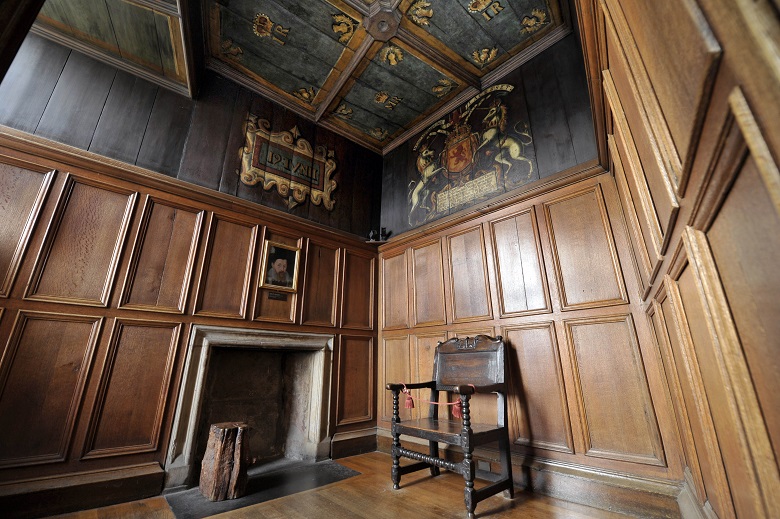
The James VI birthing room at Edinburgh Castle. Image credit: Donald MacLeod.
The infant king was cared for by the Earl and Countess of Mar at Stirling Castle until he was of age to take his place as king. Between 1567 and 1579 four men held the post of Regent and governed on behalf of James.
Esmé Stewart
The first of James’ “favourites” appeared on the scene just as 13-year-old was officially recognised as king in his own right. In October 1579 a distant relative of James’ arrived at the Scottish court to celebrate James’ coming of age and tongues started to wag.
Esmé Stewart was 37 when he was introduced to the young teenage king in Edinburgh. By this point Esmé already had at least three children. His eldest daughter was only a few years younger than James VI.
The pair soon formed a very close bond. James bestowed great treasures and titles upon his cousin, which caused much concern amongst existing courtiers. They were suspicious of this man who had gained influence and threatened their positions of power. Furthermore, at this time the Scottish court was strongly Protestant. Esmé, who had been a Catholic, was not trusted, even although he had converted to Protestantism.
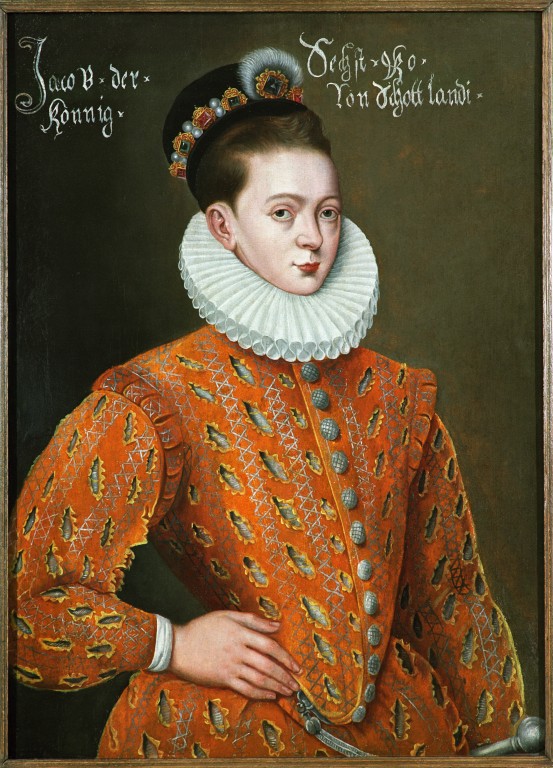
The young James VI
An intimate bond
Public displays of affection between James and Esmé were well documented. James openly kissed and embraced Esmé, leading many contemporaries to perceive their bond as unusually intimate.
Letters between the two also express strong love and devotion, using language some interpret as hinting at physical affection. James also wrote a poem, “Phoenix,” featuring a beautiful bird symbolizing a foreign lover, interpreted by some as representing Esmé and their relationship.
The nature of James VI’s relationship with Esmé Stewart has been debated for centuries. Historians remain divided on whether it constituted a “homosexual affair” in the modern understanding of the term. However, evidence suggests a very close relationship that could also have been sexual. Through the lens of today’s culture and society we would also likely see this as an example of grooming by Esmé.
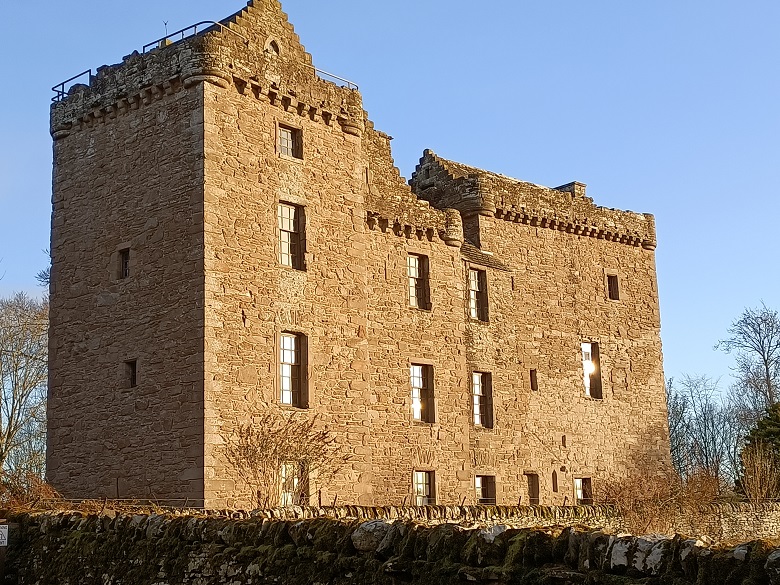
Huntingtower Castle where James was imprisoned for 10 months during the Ruthven Raid.
Whatever the nature of their relationship, Scottish nobles plotted to dissolve it. The king was lured to Ruthven Castle (now known as Huntingtower Castle), where he was held prisoner for nearly a year. This episode in Scottish history became known as the Ruthven Raid. There, under duress, the king was forced to exile Esmé on 17 September 1582. Esmé returned to France, but the pair kept up a secret correspondence. When Esmé died in 1583 his embalmed heart was sent to James.
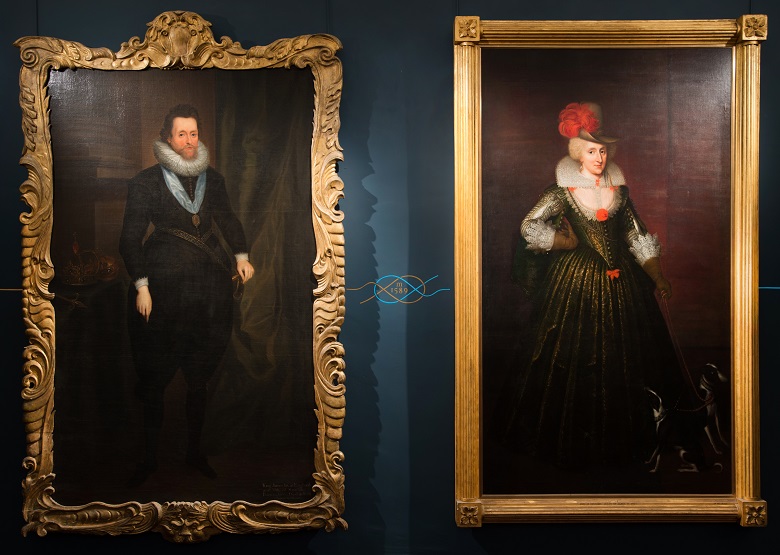
Portraits of James VI and his wife Anna of Denmark at Edinburgh Castle. The pair were married in 1589 until Anna’s death in 1619. The portrait of James is on loan from a private lender. The portrait of Anne of Denmark is on loan from the Royal Collection Trust (© His Majesty King Charles III).
Robert Carr, Earl of Somerset
More than twenty years passed before James VI met the next of his “favourites” in 1607.
Four years before, in 1603, James VI of Scotland had become James I of England and Ireland after the death of his cousin, Elizabeth I. He had moved his court to London, including his wife, Anna of Denmark, who he had married in 1589.
The king, now 40 or 41 was attending a jousting match when a 20-year-old noble, Robert Carr, was injured in the competition, breaking his leg. The king supported Robert’s recovery and a relationship grew between them.
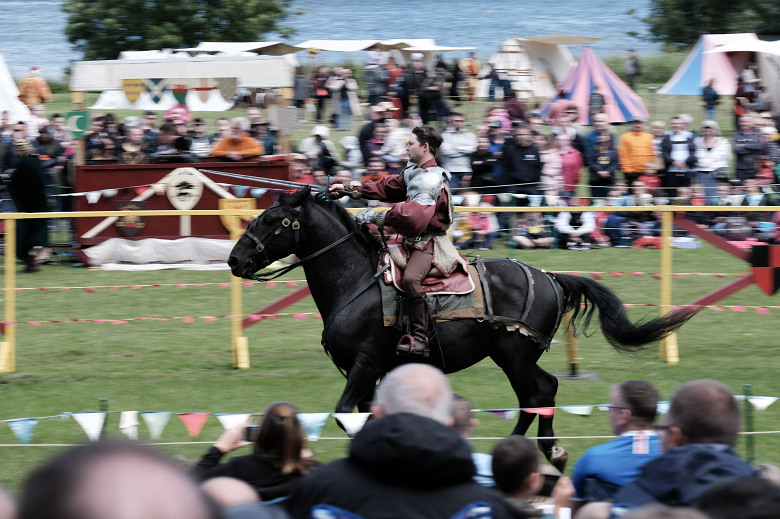
A jousting competition taking place on Linlithgow Peel.
Their relationship exhibited similar characteristics to James and Esmé’s, including expressions of strong affection and political influence. However, accusations of Robert’s involvement in a murder scandal led to the demise of their relationship in 1615.
George Villiers, 1st Duke of Buckingham
This now brings us to George Villiers. James’ third and final “favourite”.
Twenty-two-year-old George caught the eye of the king in August 1614 while at a hunt in Northamptonshire. At the time, the king was still in the sway of Robert Carr. However, enemies of Robert’s spotted the king’s infatuation with young noble and decided to capitalise on this. They bought him a new wardrobe and engineered for him to take up a role at the court.
Pushy parenting
The fact that young George was in the orbit of the king in the first place was down to his mother, Mary Villiers.
Mary was the second wife of George Villiers, an English knight, minor country gentleman and Member of Parliament from Leicestershire.
Mary, who was born around 1570, was approximately 26 years younger than her husband. She had four children with her husband: Susan (1583-1651), John (c. 1590-1658), George (1592-1628), and Christopher (c. 1593-1630). For reasons not recorded in history, Mary saw something special in her third child and he was given favourable treatment over his siblings.
It seems that the Villiers family were not particularly wealthy by the standards of nobility. However, Mary managed to find money to send George to the French court. There, he developed skills in dancing, fencing and the French language. He also picked up the courtly manners of the French.
Upon returning to England, his mother purchased him the most fashionable clothes she could afford and sent him to the English Court.
The art of seduction
One tactic that ensured George made a name for himself was his appearance in masques at the Royal Court. By taking part in these elaborate entertainments which included dance, singing and dramatic sketches, he drew the admiration of the whole court, and that of James VI and I in particular. Contemporary sources highlight Gorge’s grace as a dancer and the beauty of his body.
Godfrey Goodman (Bishop of Gloucester from 1624 to 1655) declared Villiers “the handsomest-bodied man in all of England; his limbs so well compacted, and his conversation so pleasing, and of so sweet a disposition”.
This adulation gained him more influence at court, and he climbed the social ladder very rapidly. Amongst his duties, he was given the job of tutoring the king’s son (the future Charles I) in dance.
Charles I had been born at Dunfermline Abbey in 1600 and was 8 years younger than George. They would have been around 15 and 23 when their lifelong friendship developed.
From 1615 until James’ death in 1625, the king’s ardour for George never seemed to diminish. James openly displayed his affection for Villiers, raising eyebrows at court. Titles and wealth flowed towards Villiers, culminating in his becoming Duke of Buckingham in 1623.
Writing to the king in 1623, Villiers stated: “I naturally so love your person, and adore all your other parts, which are more than ever one man had”, “I desire only to live in the world for your sake” and “I will live and die a lover of you”.
The extent of their physical intimacy remains debated, with sources suggesting a romantic and potentially sexual relationship, while others argue for a deep emotional bond without physical aspects.
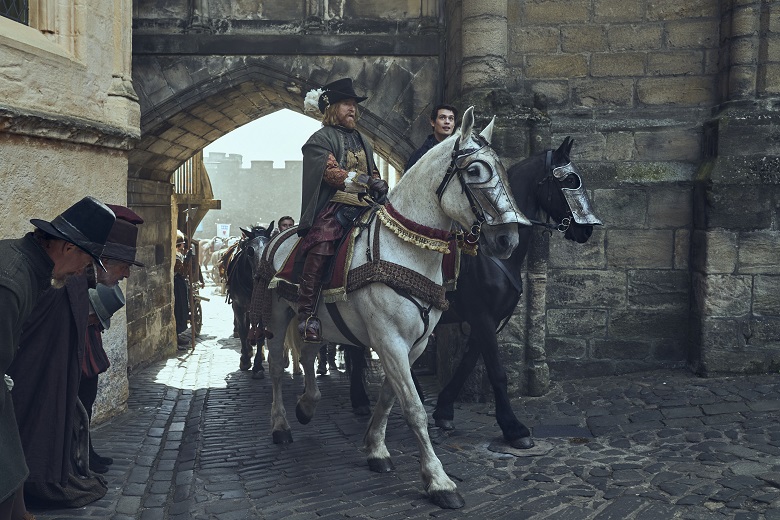
In the Sky drama ‘Mary & George’, Stirling Castle stood in for Edinburgh Castle when filming scenes set in the capital. Photo credit: Rory Mulvey/SKY UK
Golden Jubilee Tour
1617 saw celebrations of James’ Golden Jubilee as King of Scots. To mark the occasion, he returned to Scotland for the first time since he had been made king of England. The king headed to Scotland with a large entourage. George was, of course, one of those accompanying him.
At Edinburgh Castle, the Royal Palace was restored with a suite of royal apartments for the king on the first floor and his queen on the second floor.
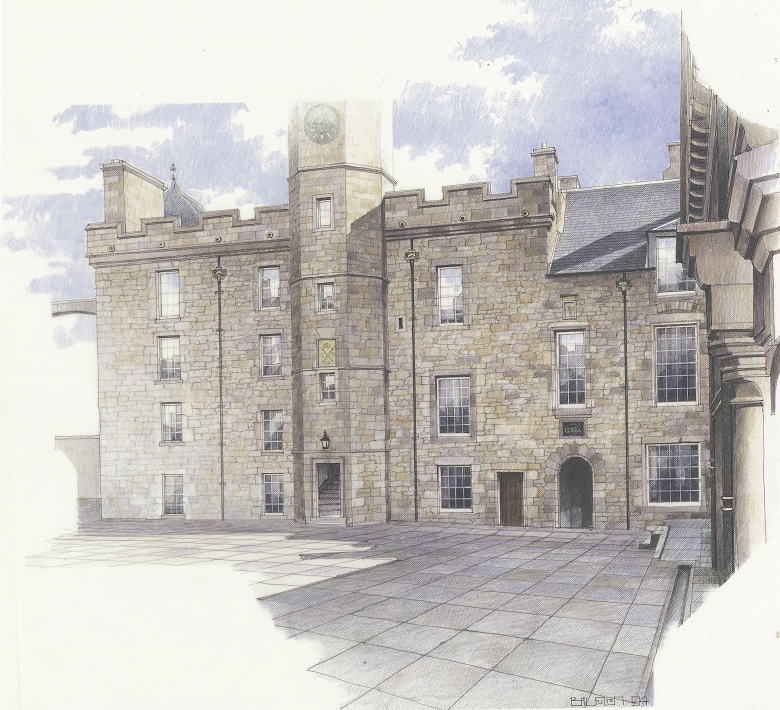
Reconstruction drawing of the Royal Palace in Crown Square at Edinburgh Castle.
However, rumour has it that George joined him in his bedchamber on this visit, rather than his wife Anne. This series of events is depicted in the Sky TV series ‘Mary & George’, with Julianne Moore, which filmed at Stirling Castle in May 2023.
While in Scotland, George was at the heart of other stooshies. James had assured Scottish nobles that he would not undertake any major political changes on his visit. However, he did use the opportunity to attempt to forge a political union between Scotland and England, beyond the union of the crowns. Scottish nobles were annoyed by the king’s controversial decision to admit five of his courtiers to the Scottish privy council. George was among the group.
A deathbed drama
Towards the end James’ reign, Buckingham’s immense influence over the King led to political decisions unpopular with Parliament and the public. These included disastrous foreign expeditions and accusations of corruption. Despite public disapproval, James’ affection for Buckingham never wavered.
In the last few years of his life, the King had become increasingly infirm. Modern doctors have suggested a combination of arthritis and kidney disease were to blame for his ill health. The King died in 1625 at Theobalds House, one of his Royal Palaces. George and his mother Mary were in attendance. Their intervention in the King’s medical treatment caused a scandal at the time.
The Scottish nobleman, Thomas Erskine, 1st Earl of Kellie, who had been a friend of James’ since childhood, was also at the scene and recorded that:
There has something fallen out here much disliked, and I for myself think much mistaken, and that is this. My Lord of Bukkinghame wishing mutche the Kings healthe caused splaister to be applyed to the Kings breast, after which his Majesty was extremely sick, and with all did give him a drink or syrup to drink; and this was which has spread such a business here and discontent as you would wonder, and Doctor Craig is now absented from court and Harry Gibb of the bedchamber is quarrelled for it, and my Lord Buckingham so incensed”
Falling from grace
James died on 27 March 1625. George was initially a powerful figure in the reign of Charles I. However, over the next few years his favour waned under the new king.
Villiers had become increasingly unpopular with the public. He was dogged by perceived failures in the Thirty Years’ War and personal scandals.
This resentment came to a head on 23 August 1628. While in Portsmouth preparing for another military campaign Villiers was assassinated. A disgruntled former military officer called John Felton, disillusioned with the Duke’s leadership and motivated by religious and political beliefs, entered the Greyhound Inn and stabbed George.
George Villiers was interred at Westminster Abbey. When his mother, Mary, died five years later, she was interred beside him. Their lavish monument, with depictions of them lying side by side, can still be visited at Westminster Abbey today.
Was King James VI a gay or bisexual king?
This is something that it’s impossible to answer simply and definitively. It’s vital to understand that concepts of sexuality in the 16th and 17th centuries differed from modern definitions. While the terms “gay” or “bisexual” were not in use in Renaissance culture, same-sex relationships and relationships with both sexes existed.
We also know that James’ behaviour towards his favourites was seen as unusual and suggestive even by the standards of his time.
Many historians now agree that substantial historical evidence suggests that King James VI was likely either gay or bisexual. While definitive proof may be elusive, the combination of his close relationships with male favourites, contemporary accounts, and his own writings make a compelling case for his attraction to men.

